check engine light CHEVROLET COBALT 2007 1.G User Guide
[x] Cancel search | Manufacturer: CHEVROLET, Model Year: 2007, Model line: COBALT, Model: CHEVROLET COBALT 2007 1.GPages: 450, PDF Size: 2.48 MB
Page 231 of 450
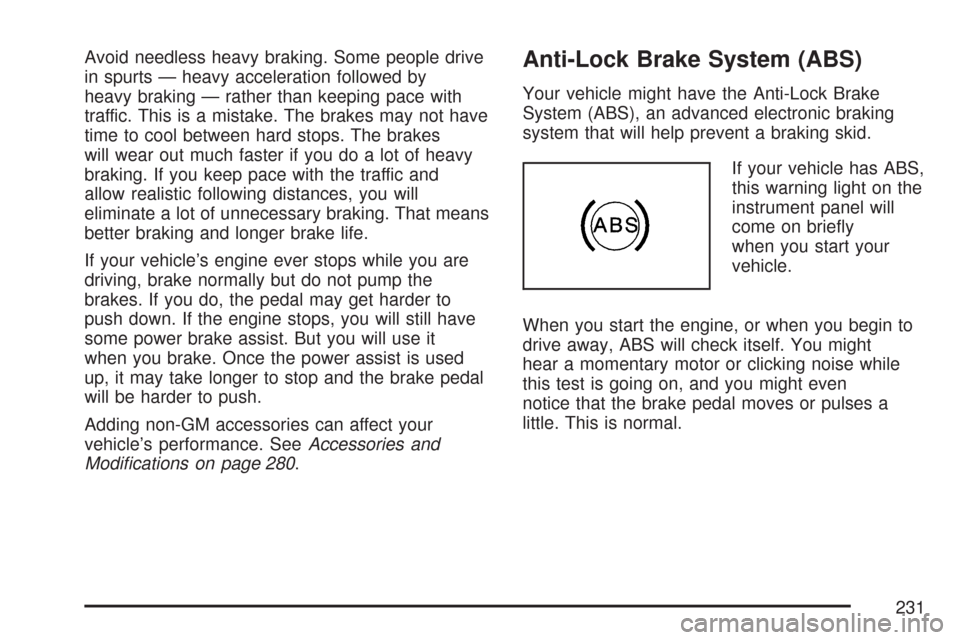
Avoid needless heavy braking. Some people drive
in spurts — heavy acceleration followed by
heavy braking — rather than keeping pace with
traffic. This is a mistake. The brakes may not have
time to cool between hard stops. The brakes
will wear out much faster if you do a lot of heavy
braking. If you keep pace with the traffic and
allow realistic following distances, you will
eliminate a lot of unnecessary braking. That means
better braking and longer brake life.
If your vehicle’s engine ever stops while you are
driving, brake normally but do not pump the
brakes. If you do, the pedal may get harder to
push down. If the engine stops, you will still have
some power brake assist. But you will use it
when you brake. Once the power assist is used
up, it may take longer to stop and the brake pedal
will be harder to push.
Adding non-GM accessories can affect your
vehicle’s performance. SeeAccessories and
Modi�cations on page 280.Anti-Lock Brake System (ABS)
Your vehicle might have the Anti-Lock Brake
System (ABS), an advanced electronic braking
system that will help prevent a braking skid.
If your vehicle has ABS,
this warning light on the
instrument panel will
come on brie�y
when you start your
vehicle.
When you start the engine, or when you begin to
drive away, ABS will check itself. You might
hear a momentary motor or clicking noise while
this test is going on, and you might even
notice that the brake pedal moves or pulses a
little. This is normal.
231
Page 257 of 450
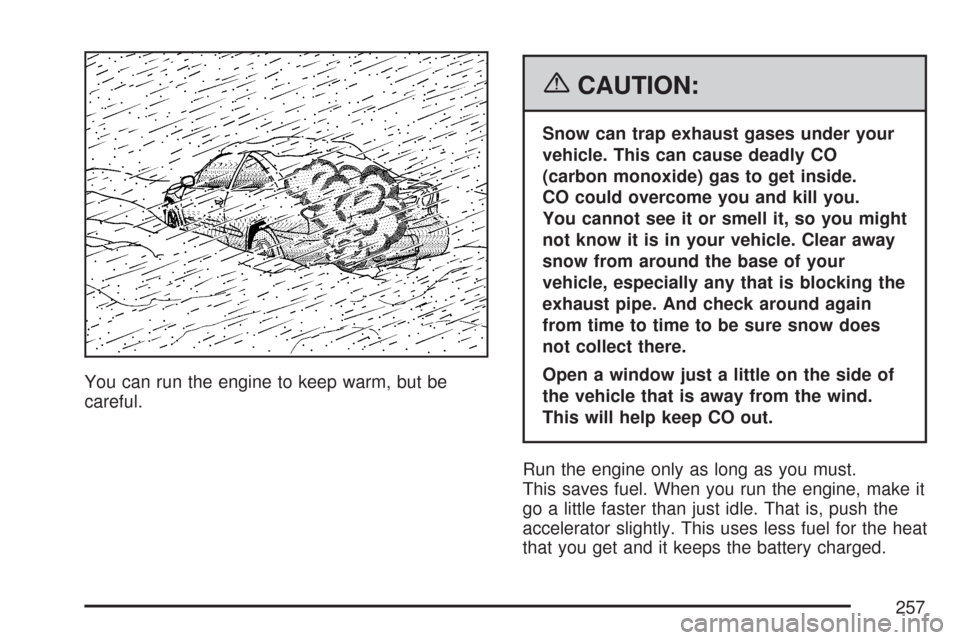
You can run the engine to keep warm, but be
careful.
{CAUTION:
Snow can trap exhaust gases under your
vehicle. This can cause deadly CO
(carbon monoxide) gas to get inside.
CO could overcome you and kill you.
You cannot see it or smell it, so you might
not know it is in your vehicle. Clear away
snow from around the base of your
vehicle, especially any that is blocking the
exhaust pipe. And check around again
from time to time to be sure snow does
not collect there.
Open a window just a little on the side of
the vehicle that is away from the wind.
This will help keep CO out.
Run the engine only as long as you must.
This saves fuel. When you run the engine, make it
go a little faster than just idle. That is, push the
accelerator slightly. This uses less fuel for the heat
that you get and it keeps the battery charged.
257
Page 283 of 450
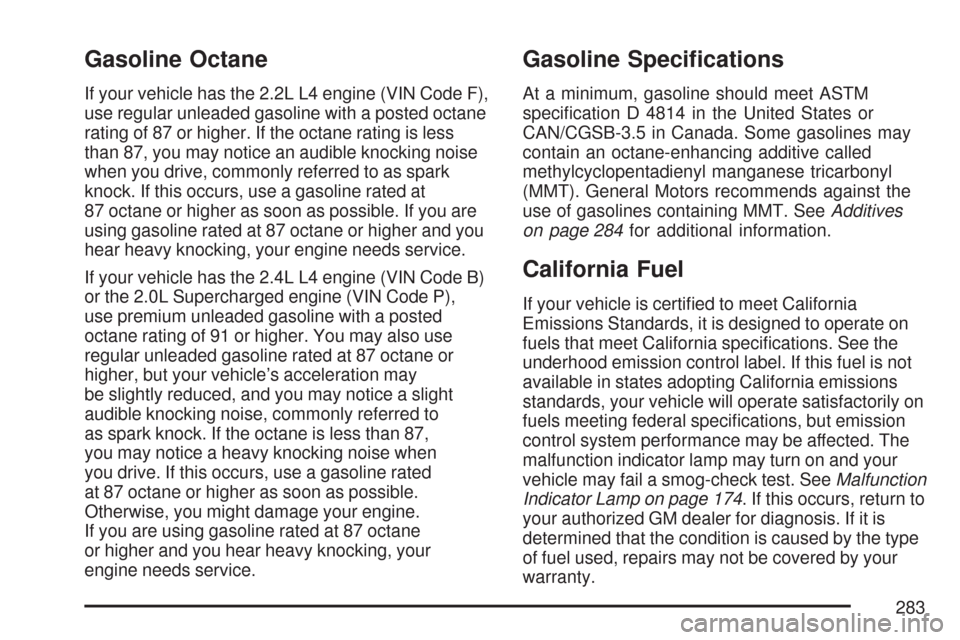
Gasoline Octane
If your vehicle has the 2.2L L4 engine (VIN Code F),
use regular unleaded gasoline with a posted octane
rating of 87 or higher. If the octane rating is less
than 87, you may notice an audible knocking noise
when you drive, commonly referred to as spark
knock. If this occurs, use a gasoline rated at
87 octane or higher as soon as possible. If you are
using gasoline rated at 87 octane or higher and you
hear heavy knocking, your engine needs service.
If your vehicle has the 2.4L L4 engine (VIN Code B)
or the 2.0L Supercharged engine (VIN Code P),
use premium unleaded gasoline with a posted
octane rating of 91 or higher. You may also use
regular unleaded gasoline rated at 87 octane or
higher, but your vehicle’s acceleration may
be slightly reduced, and you may notice a slight
audible knocking noise, commonly referred to
as spark knock. If the octane is less than 87,
you may notice a heavy knocking noise when
you drive. If this occurs, use a gasoline rated
at 87 octane or higher as soon as possible.
Otherwise, you might damage your engine.
If you are using gasoline rated at 87 octane
or higher and you hear heavy knocking, your
engine needs service.
Gasoline Speci�cations
At a minimum, gasoline should meet ASTM
speci�cation D 4814 in the United States or
CAN/CGSB-3.5 in Canada. Some gasolines may
contain an octane-enhancing additive called
methylcyclopentadienyl manganese tricarbonyl
(MMT). General Motors recommends against the
use of gasolines containing MMT. SeeAdditives
on page 284for additional information.
California Fuel
If your vehicle is certi�ed to meet California
Emissions Standards, it is designed to operate on
fuels that meet California speci�cations. See the
underhood emission control label. If this fuel is not
available in states adopting California emissions
standards, your vehicle will operate satisfactorily on
fuels meeting federal speci�cations, but emission
control system performance may be affected. The
malfunction indicator lamp may turn on and your
vehicle may fail a smog-check test. SeeMalfunction
Indicator Lamp on page 174. If this occurs, return to
your authorized GM dealer for diagnosis. If it is
determined that the condition is caused by the type
of fuel used, repairs may not be covered by your
warranty.
283
Page 325 of 450

{CAUTION:
Using a match near a battery can cause
battery gas to explode. People have been
hurt doing this, and some have been
blinded. Use a �ashlight if you need
more light.
Be sure the battery has enough water.
You do not need to add water to the battery
installed in your new vehicle. But if a
battery has �ller caps, be sure the right
amount of �uid is there. If it is low, add
water to take care of that �rst. If you don’t,
explosive gas could be present.
Battery �uid contains acid that can
burn you. Do not get it on you. If you
accidentally get it in your eyes or on your
skin, �ush the place with water and get
medical help immediately.
{CAUTION:
Fans or other moving engine parts can
injure you badly. Keep your hands away
from moving parts once the engine is
running.
5. Check that the jumper cables do not have
loose or missing insulation. If they do, you
could get a shock. The vehicles could
be damaged too.
Before you connect the cables, here are some
basic things you should know. Positive (+) will
go to positive (+) or to a remote positive (+)
terminal if the vehicle has one. Negative (−) will
go to a heavy, unpainted metal engine part or
to a remote negative (−) terminal if the vehicle
has one.
Do not connect positive (+) to negative (−)or
you will get a short that would damage the
battery and maybe other parts too. And do
not connect the negative (−) cable to the
negative (−) terminal on the dead battery
because this can cause sparks.
325
Page 386 of 450
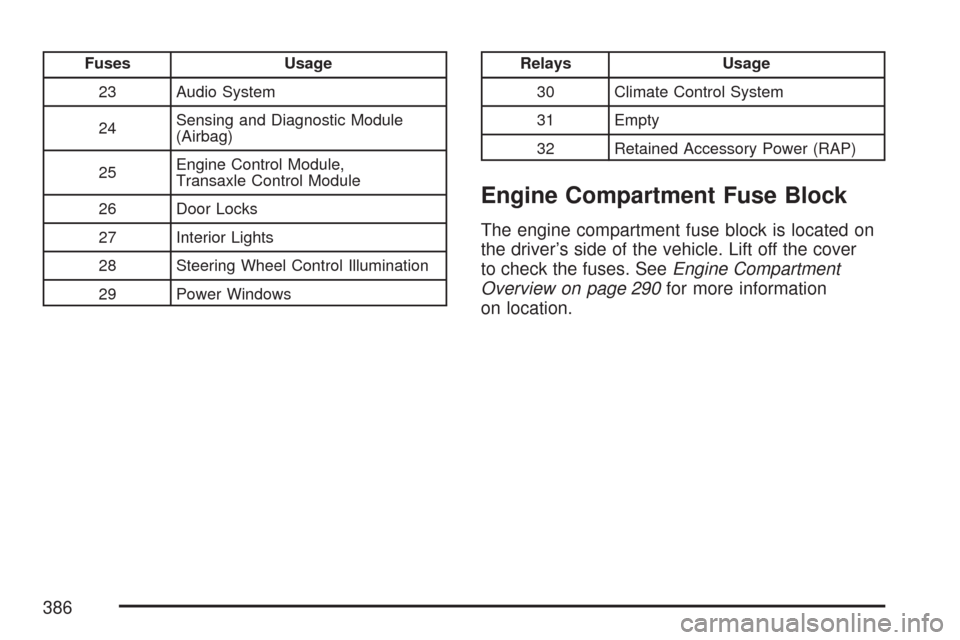
Fuses Usage
23 Audio System
24Sensing and Diagnostic Module
(Airbag)
25Engine Control Module,
Transaxle Control Module
26 Door Locks
27 Interior Lights
28 Steering Wheel Control Illumination
29 Power WindowsRelays Usage
30 Climate Control System
31 Empty
32 Retained Accessory Power (RAP)
Engine Compartment Fuse Block
The engine compartment fuse block is located on
the driver’s side of the vehicle. Lift off the cover
to check the fuses. SeeEngine Compartment
Overview on page 290for more information
on location.
386
Page 437 of 450
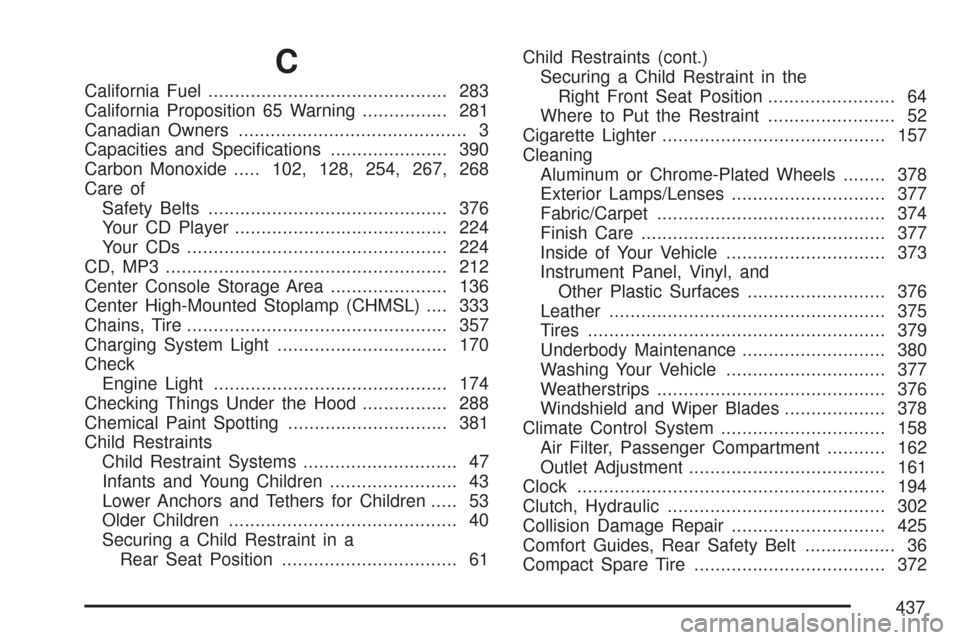
C
California Fuel............................................. 283
California Proposition 65 Warning................ 281
Canadian Owners........................................... 3
Capacities and Speci�cations...................... 390
Carbon Monoxide.....102, 128, 254, 267, 268
Care of
Safety Belts............................................. 376
Your CD Player........................................ 224
Your CDs ................................................. 224
CD, MP3 ..................................................... 212
Center Console Storage Area...................... 136
Center High-Mounted Stoplamp (CHMSL).... 333
Chains, Tire................................................. 357
Charging System Light................................ 170
Check
Engine Light............................................ 174
Checking Things Under the Hood................ 288
Chemical Paint Spotting.............................. 381
Child Restraints
Child Restraint Systems............................. 47
Infants and Young Children........................ 43
Lower Anchors and Tethers for Children..... 53
Older Children........................................... 40
Securing a Child Restraint in a
Rear Seat Position................................. 61Child Restraints (cont.)
Securing a Child Restraint in the
Right Front Seat Position........................ 64
Where to Put the Restraint........................ 52
Cigarette Lighter.......................................... 157
Cleaning
Aluminum or Chrome-Plated Wheels........ 378
Exterior Lamps/Lenses............................. 377
Fabric/Carpet........................................... 374
Finish Care.............................................. 377
Inside of Your Vehicle.............................. 373
Instrument Panel, Vinyl, and
Other Plastic Surfaces.......................... 376
Leather.................................................... 375
Tires........................................................ 379
Underbody Maintenance........................... 380
Washing Your Vehicle.............................. 377
Weatherstrips........................................... 376
Windshield and Wiper Blades................... 378
Climate Control System............................... 158
Air Filter, Passenger Compartment ........... 162
Outlet Adjustment..................................... 161
Clock.......................................................... 194
Clutch, Hydraulic......................................... 302
Collision Damage Repair............................. 425
Comfort Guides, Rear Safety Belt................. 36
Compact Spare Tire.................................... 372
437
Page 439 of 450
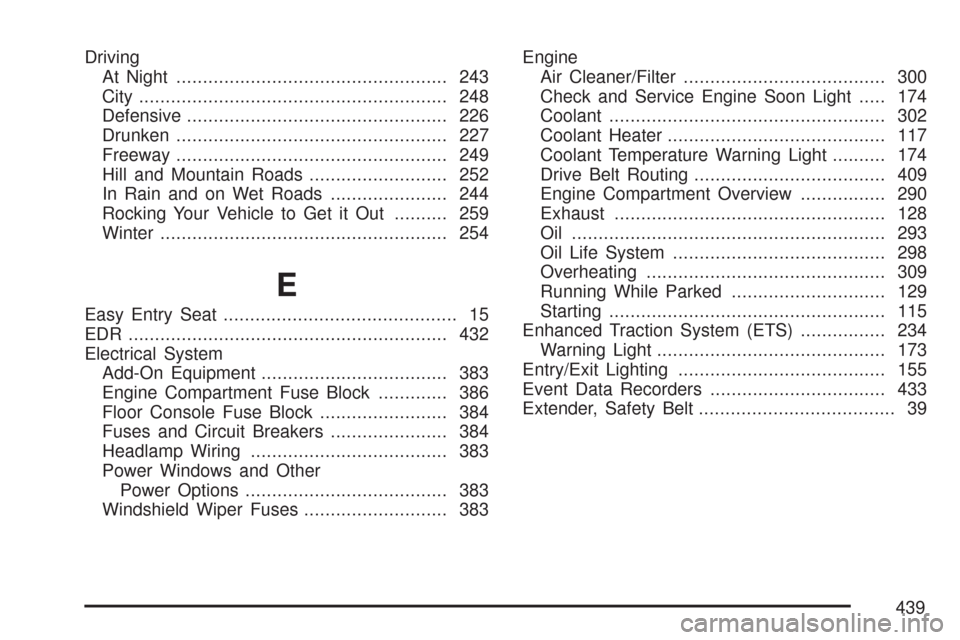
Driving
At Night................................................... 243
City.......................................................... 248
Defensive................................................. 226
Drunken................................................... 227
Freeway................................................... 249
Hill and Mountain Roads.......................... 252
In Rain and on Wet Roads...................... 244
Rocking Your Vehicle to Get it Out.......... 259
Winter...................................................... 254
E
Easy Entry Seat............................................ 15
EDR ............................................................ 432
Electrical System
Add-On Equipment................................... 383
Engine Compartment Fuse Block............. 386
Floor Console Fuse Block........................ 384
Fuses and Circuit Breakers...................... 384
Headlamp Wiring..................................... 383
Power Windows and Other
Power Options...................................... 383
Windshield Wiper Fuses........................... 383Engine
Air Cleaner/Filter...................................... 300
Check and Service Engine Soon Light..... 174
Coolant.................................................... 302
Coolant Heater......................................... 117
Coolant Temperature Warning Light.......... 174
Drive Belt Routing.................................... 409
Engine Compartment Overview................ 290
Exhaust................................................... 128
Oil ........................................................... 293
Oil Life System........................................ 298
Overheating............................................. 309
Running While Parked............................. 129
Starting.................................................... 115
Enhanced Traction System (ETS)................ 234
Warning Light........................................... 173
Entry/Exit Lighting....................................... 155
Event Data Recorders................................. 433
Extender, Safety Belt..................................... 39
439
Page 444 of 450
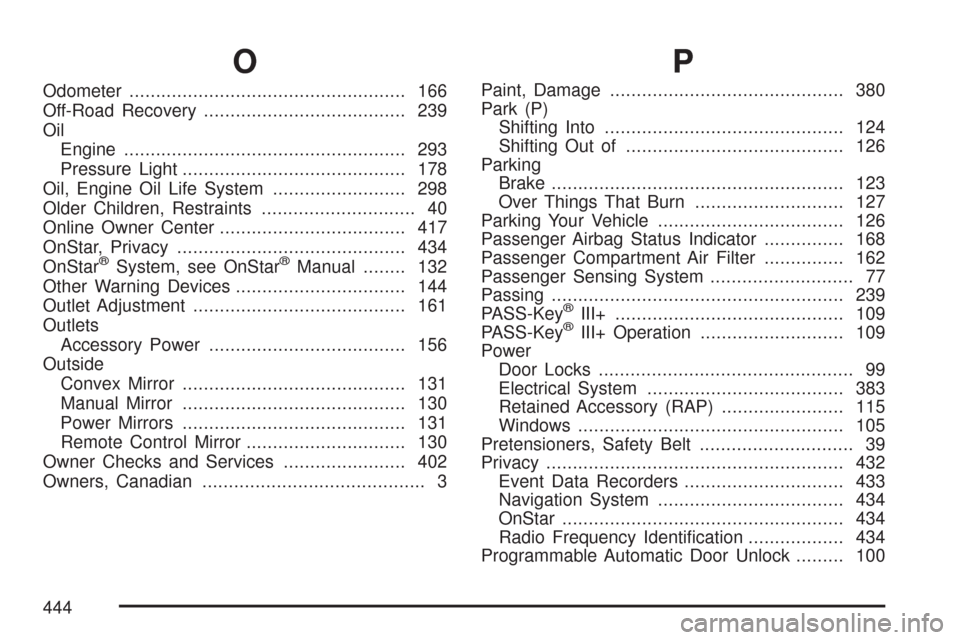
O
Odometer.................................................... 166
Off-Road Recovery...................................... 239
Oil
Engine..................................................... 293
Pressure Light.......................................... 178
Oil, Engine Oil Life System......................... 298
Older Children, Restraints............................. 40
Online Owner Center................................... 417
OnStar, Privacy........................................... 434
OnStar
®System, see OnStar®Manual........ 132
Other Warning Devices................................ 144
Outlet Adjustment........................................ 161
Outlets
Accessory Power..................................... 156
Outside
Convex Mirror.......................................... 131
Manual Mirror.......................................... 130
Power Mirrors.......................................... 131
Remote Control Mirror.............................. 130
Owner Checks and Services....................... 402
Owners, Canadian.......................................... 3
P
Paint, Damage............................................ 380
Park (P)
Shifting Into............................................. 124
Shifting Out of......................................... 126
Parking
Brake....................................................... 123
Over Things That Burn............................ 127
Parking Your Vehicle................................... 126
Passenger Airbag Status Indicator............... 168
Passenger Compartment Air Filter............... 162
Passenger Sensing System........................... 77
Passing....................................................... 239
PASS-Key
®III+........................................... 109
PASS-Key®III+ Operation........................... 109
Power
Door Locks................................................ 99
Electrical System..................................... 383
Retained Accessory (RAP)....................... 115
Windows.................................................. 105
Pretensioners, Safety Belt............................. 39
Privacy........................................................ 432
Event Data Recorders.............................. 433
Navigation System................................... 434
OnStar..................................................... 434
Radio Frequency Identi�cation.................. 434
Programmable Automatic Door Unlock......... 100
444